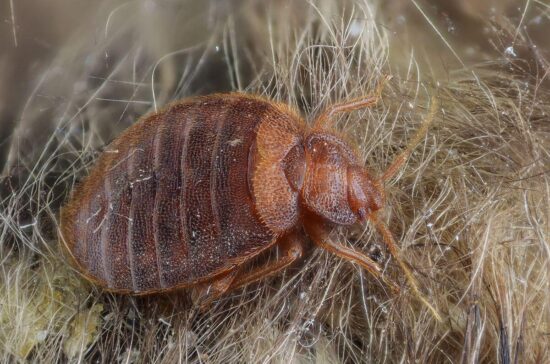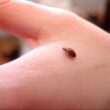Finding bed bugs in your home is every homeowner’s nightmare. These tiny bloodsuckers can turn your peaceful bedroom into a stress zone overnight. When you’re dealing with a bed bug problem, one of the biggest questions becomes: where to sleep if you have bed bugs without making things worse?
The answer might surprise you. Most people’s first instinct is to run to another room or book a hotel, but pest control experts have some counterintuitive advice that could save you from spreading these pests throughout your entire home.
Let’s look at your real options and what actually works when you need a safe place to sleep during a bed bug infestation.
1. Stay in Your Own Bed (The Best Choice According to Experts)
Here’s the advice nobody wants to hear: the best place to sleep when you have bed bugs is right where you found them. This might sound crazy, but there’s solid science behind this recommendation.
Why staying put actually works:
Bed bugs need human blood to survive, which makes you their main target. These pests are incredibly persistent hunters. If you move to another room, they won’t just give up and disappear. Instead, they’ll follow you to your new location and set up shop there too. Before you know it, you’ll have bed bugs in multiple rooms instead of just one.
Staying in the bedbug-infested room helps keep the little beasties contained, limiting their opportunity to take over other locations. Think of it like quarantine, but for bugs.
- Kill bed bugs and bed bug eggs
- Use spray as a spot treatment around bed frames, mattress seams/tufts/folds, and baseboards
- Kills even the toughest bed bugs
- The continuous spray Comfort Wand easily gets into hard-to-reach areas
How to make your infested bed safer:
Just because you’re staying doesn’t mean you have to suffer through endless bites. Here are some practical steps to protect yourself:
Encase your mattress and box spring in special bed bug covers. These create a barrier that traps any bugs inside your mattress where they can’t reach you. Once the encasements are sealed, any bed bugs inside the mattress cannot escape or feed, and they will eventually die.
Wash all bedding daily in the hottest water possible, then dry on high heat for at least 30 minutes. Heat kills bed bugs and their eggs, so this gives you fresh, bug-free sheets each night.
Wear full coverage pajamas that cover you from head to toe. Bed bugs are unable to bite through clothing, so the more skin you have covered, the less there is for bed bugs to snack on. Make sure your sleepwear fits snugly so bugs can’t crawl underneath.
Install bed bug interceptors under all four legs of your bed frame. These cups trap bed bugs attempting to climb onto your bed and help confirm that an infestation is gone when there are no longer trapped bed bugs.
Move your bed away from walls and make sure your bedding doesn’t touch the floor. This forces bed bugs to use the bed legs as their only path to reach you, where your interceptors will catch them.
2. Sleep on an Air Mattress (A Safer Temporary Option)
If staying in your regular bed feels impossible, an air mattress can be a smart temporary solution. While not perfect, inflatable mattresses have some real advantages when dealing with bed bugs.
Why air mattresses work better:
Unlike a normal bed, there are fewer hiding spots for bed bugs to build a colony on an air mattress due to the smooth surface of the plastic. Traditional mattresses have countless seams, fabric layers, and crevices where bugs can hide. Air mattresses are much simpler.
Bed bugs cannot penetrate within the inflatable mattress as they are not able to bite their way through plastic. This means any bugs that do get on your air mattress will stay on the surface where you can see and remove them more easily.
Setting up your air mattress safely:
Use a proper bed frame to get your air mattress off the floor. Elevate your air mattress on a bed frame or platform to minimize the risk of bed bugs crawling onto it. Floor-level sleeping makes you an easy target.
Add a protective cover designed specifically for air mattresses. Use a mattress encasement specifically designed to keep bed bugs out with zipper closure that seals off the mattress, preventing any bugs from getting in or out.
Install interceptors under your air mattress frame legs, just like with a regular bed. This creates a protective barrier that catches bugs before they reach you.
Inspect regularly for any signs of bed bug activity. Look for dark spots, bloodstains, or live bugs on the surface. Since air mattresses have fewer hiding spots, problems are easier to spot early.
3. Sleep on the Couch (Risky but Sometimes Necessary)
Sometimes people feel they have no choice but to move to the living room couch. While this isn’t ideal, there are ways to make it less risky if you absolutely must go this route.
Why couches aren’t recommended:
If you move to another room to sleep, the bed bugs will eventually follow, then you’ll have bed bugs in multiple rooms. Living rooms with sofas are actually the second most common place for bed bug infestations after bedrooms.
Moving to your couch essentially gives bed bugs a new territory to colonize. You might get a few nights of relief, but you’re likely creating a bigger problem for yourself later.
If you must use the couch:
Inspect the couch first for any existing signs of bed bugs. Look for red and black spots, insect skins, eggs, and the bugs themselves in the darkest crevices of the sofa. Check all seams, cushions, and underneath the furniture.
Protect the couch with a washable sheet or cover that you can launder immediately after use. This prevents any bugs you might bring with you from getting into the couch fabric.
Follow strict moving protocols to avoid bringing bugs with you. Change into completely clean clothes that have been stored away from your bedroom. Take a shower before settling in for the night.
Set up interceptors if your couch has legs. Install interceptors to the legs of your sofa with a plastic and glossy coating to stop bed bugs from being able to climb into the sofa.
4. Sleep in a Different Room (High Risk Strategy)
Moving to a guest room or spare bedroom is another option people consider, but it comes with serious risks that you need to understand.
Why this can backfire:
If you move rooms or start sleeping on the couch you run the risk of contaminating these other areas of your home. Bed bugs don’t give up easily. They can travel between rooms through wall voids, electrical outlets, and even by following you directly.
Most people don’t realize they have bed bugs until the infestation has been growing for months. There’s a good chance bugs have already spread to other rooms in your house, making your “safe” room not so safe after all.
If you decide to try another room:
Use the strictest protocols possible to avoid bringing bugs with you. This means changing into completely fresh clothes that have been stored in sealed bags away from the infected area.
Shower thoroughly before entering the new room to remove any bugs that might be on your body.
Don’t bring anything from the infested room. No clothes, books, electronics, or personal items. Everything stays in the original room.
Set up immediate protection in the new room with interceptors, mattress encasements, and all the same precautions you’d use in your original bedroom.
Monitor closely for signs that bugs have followed you. Check for bites, bloodstains, or live bugs every morning.
- Kill bed bugs and bed bug eggs
- Use spray as a spot treatment around bed frames, mattress seams/tufts/folds, and baseboards
- Kills even the toughest bed bugs
- The continuous spray Comfort Wand easily gets into hard-to-reach areas
5. Use a Sleeping Bag with Protective Liner
For people who want extra protection or are sleeping away from home, a properly set up sleeping bag can create an effective barrier against bed bugs.
How sleeping bags help:
Sleeping bags can serve as bed bug barriers by creating a physical barrier and avoiding contact with infested bedding. They work especially well for travel situations where you’re not sure about the cleanliness of your accommodation.
Silk liners designed for sleeping bags are the best choice for minimizing contact, with anecdotal evidence from hikers and travelers suggesting that bites are reduced, if not eliminated, when sleepers encase themselves in this type of protective cocoon.
Setting up your protective sleeping system:
Choose the right sleeping bag with features that help keep bugs out. Look for sleeping bags that can be cinched up around your neck, creating a protective cocoon that keeps bugs out. Mummy-style bags work best because they have minimal openings.
Add a treated liner for extra protection. You can treat silk or polyester liners with natural repellents or purchase pre-treated options.
Use natural repellents on your sleeping system. Fill a travel spray bottle with water and add 5 drops each of clove, cinnamon, tea tree, peppermint, lavender, and eucalyptus oils. Spray both inside and outside of your sleeping bag and allow it to dry completely.
Position carefully on a clean surface away from walls when possible. Even with a protective sleeping bag, location matters for reducing your exposure to bugs.
6. Sleep in Your Car (Emergency Last Resort Only)
Sleeping in your car should only be considered in extreme emergency situations where other options truly aren’t available. While some travelers have reported doing this to avoid severe hotel infestations, it comes with significant risks and limitations.
When this might be considered:
Some people have chosen to sleep in their cars when facing severe bed bug problems in hotels or temporary housing. As one traveler commented about their hotel stay: “Bed bugs, no handling of the matter and no treatment. You’re better off sleeping in your car”.
Important risks to understand:
Bed bugs can get into your car if they get onto your clothes, furniture, bags, or other items that you bring into your car. Once in your vehicle, they can survive for extended periods and potentially re-infest your home later.
Bed bugs can only live in temperatures above 46 degrees Fahrenheit and most species can’t survive anywhere above 113 degrees Fahrenheit. This means extreme weather can either kill bugs or make car sleeping impossible for you too.
If you absolutely must try this:
Clean everything thoroughly before getting in your car. Change into completely fresh clothes and inspect everything you bring into the vehicle.
Use protective barriers like sleeping bags and treated liners to create distance between you and any potential bugs.
Consider safety and legal issues like local laws about sleeping in vehicles, proper ventilation, and emergency access.
Plan for re-entry to your home with protocols to prevent bringing any car-dwelling bugs back inside.
7. Stay with Friends or Family (Strongly Not Recommended)
While it might seem tempting to escape to a friend’s or family member’s house, this option carries huge risks for everyone involved.
Why this can destroy relationships:
Friends and family might not realize they’re giving bed bugs a free ride straight to your doorstep, as these critters are master hitchhikers that can cling onto clothing, bags, or any personal items with ease.
Bed bug infestations are expensive and traumatic to deal with. Accidentally giving bugs to people you care about can seriously damage your relationships and leave you responsible for costly extermination bills.
The risks are higher than you think:
Even brief encounters with infested environments can result in these pests finding their way into your vehicle and then into other homes. Bed bugs are incredibly good at hiding in the smallest spaces and can survive without feeding for months.
If you absolutely must visit others:
Only wear clothes or carry items that have been heat treated and stored in sealed airtight containers. This means washing and drying everything on high heat, then storing in sealed bags until you’re ready to leave.
Change clothes completely before entering their home. Bring a fresh set of clothes that have been stored separately and change in your car or garage.
Avoid bedrooms entirely and stay in common areas only. Stay away from areas where people sleep, as this is where bed bugs are most likely to be.
Be honest about your situation so your hosts can make informed decisions and take their own precautions.
8. Sleep on the Floor with Protection
If your bed is heavily infested and you can’t get an air mattress right away, sleeping on the floor with proper protection can be a temporary solution.
Setting up a protected floor sleeping area:
Create multiple barriers between you and the floor. Start with a waterproof tarp or plastic sheeting, add a thick blanket or sleeping bag, and top with treated bedding.
Stay away from walls where bugs might be hiding or traveling. Keep the bed away from walls and bedding off the floor so that bed bugs do not touch the floor or walls.
Use interceptor-style protection around your sleeping area. You can create barriers using double-sided tape or commercial interceptor products placed around your sleeping zone.
Inspect and clean daily the area where you’re sleeping. Vacuum thoroughly and look for any signs of bug activity.
Consider this temporary only while you arrange for proper treatment or better sleeping accommodations. Floor sleeping isn’t sustainable long-term and has its own health and comfort issues.
What You Should Never Do
Don’t go to hotels. Because of the huge risk of transporting bed bugs to new locations and out of courtesy to others, experts don’t recommend staying in hotels. You could spread your problem to other travelers and potentially face legal issues.
Don’t throw out your mattress immediately. It’s generally unnecessary to throw away beds or bedding, and chances are that any new mattresses brought into the home will quickly become re-infested. With proper treatment, most furniture can be saved.
Don’t panic and scatter to multiple rooms. Moving randomly between rooms increases the spread. Early detection and early reporting are key. The more bed bugs you have, the greater the chance of spreading them.



